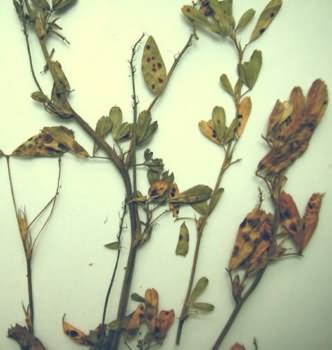Diseases
Pseudopeziza jonesii Nannf. - Yellow Leaf Blotch of Alfalfa
Systematic position.
Class Ascomycetes, order Leotiales, family Dermateacea, genus Pseudopeziza (anamorph - Sporonema phacidioides Desmaz. = Gloeosporium morianum Sacc.).Synonyms.
Pyrenopeziza medicaginis Fuckel, Leptotrochila medicaginis (Fuckel) H. Schuepp.Biological group.
His is a biotroph.Morphology and biology.
P. jonesii is a specialized parasite infecting mainly Lucerne species. Large light yellow blotches appear on leaves, sometimes on stalks. On blotches small dark points of the fungal sporodochia are visible, producing conidia. Conidia are unable to infect plants. Their role in the fungus development is unknown. As the disease progresses the leaves darken, roll and dry, falling down or remaining on stalk. Apothecia are formed on dried leaves. Infection of plants occurs only by ascospores leaving the ascus during damp weather. During a season one or several generations may be formed, depending on climatic conditions. Apothecia are located on thick short pedicel, 200-1000 microns in diameter. Ascus size is 60-70 x 9-10 microns. There are eight spores (10 x 5 microns) in each ascus. The fungus over-winters as formed or rudimentary apothecia in fallen leaves and leaf fragments on soil surface. In spring apothecia ripen and form ascospores that are a source of initial infection.Distribution.
The disease is common in alfalfa areas in Europe, America, and other countries. On the former USSR territory it is found in all regions of alfalfa cultivation, except for Northwestern and Central European regions, especially in zones where the annual amount of precipitations does not exceed 500 mm.Ecology.
The fungus develops most successfully at high temperatures, 18-24.C. Maximum disease intensity is observed with the alternation of hot dry and damp weather. The first condition is necessary for fungus growth in plant tissue, and the second one for ascospore distribution. At the above-stated temperature the first yellow blotches occur on leaves 12-15 days after the fungus invasion, then apothecia appear in 8-10 and more days, ripening 4-6 days after appearance.Economic significance.
Although plants are not destroyed by the disease, the death of leaves causes a loss of vigor, reducing hay yield weight by 30-80%. Depending on climatic conditions, the disease may be more harmful for the first (Uzbekistan) or second (Ukraine) hay harvest. Besides this, the hay of infected plants loses nutritious qualities; the quantity of nitrogen can be reduced by 20%. Seeds in infected pods have lower germination. Control measures include: removal of residues in spring, cultivation of alfalfa in mixtures with other leguminous or cereal grasses, cultivation of resistant varieties. Fertilization (especially with potassium) and good management practices can also help to reduce losses. In seed fields treatments by foliar fungicides is possible.Reference citations:
Ainsworth G.C., ed. 1971. Ainsworth and Bisby's Dictionary of the fungi. 6 ed. Kew, Surrey: CAB Intern. 663 p.Hawksworth D.L., Kirk P.M., Sutton B.C., Pegler D.M. 1995. Ainsworth & Bisby.s Dictionary of the fungi. Kew: CAB International. 616 p.
Karavyanskii N.S., Mazur O.P. 1975. Diseases and pests of forage crops. Moscow: Rosselhozizdat. 246 p. (In Russian)
Karavyanskii N.S., Mazur O.P. 1984. Complex system. Zashchita rastenii 10: 24-26. (In Russian)
Salunska N.I. 1965. Prognosis of yellow leaf blotch of alfalfa in connection with development cycle of its causal agent. Zahyst Roslyn 2: 76-85. (In Ukrainian)
Salunskaya N.I. 1969. Diseases and pests of grasses (trefoil and alfalfa) and measures of their control. Moscow. 67-94 p. (In Russian)
Tarkovskii M.I. 1974. Lucerne. Moscow: Kolos. 240 p. (In Russian)
Teryaev S.A. 1971. Common and yellow alfalfa spots in the central zone of Stavropol Territory conditions. Coll. of scientific works of young scientists. Stavropol: Stavropol Sci. Res. Inst. of Agr. Issue 4. 103-110 p. (In Russian)
© Dmitriev A.P.


